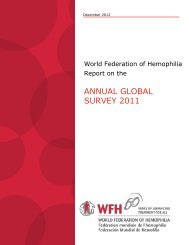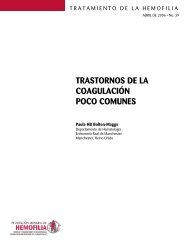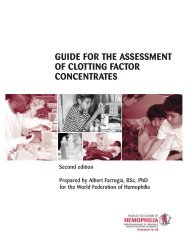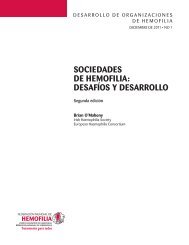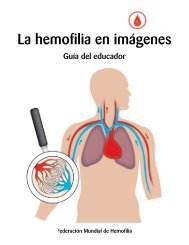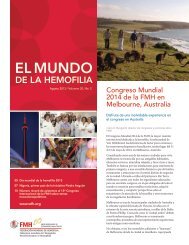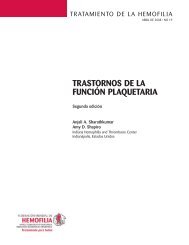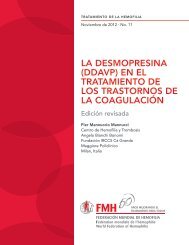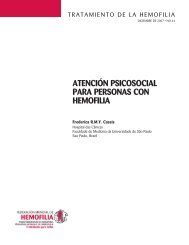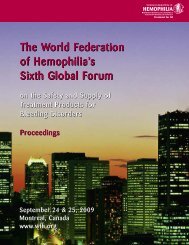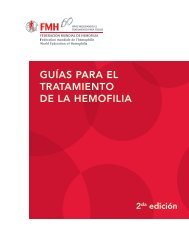ACQUIRED HEMOPHILIA - World Federation of Hemophilia
ACQUIRED HEMOPHILIA - World Federation of Hemophilia
ACQUIRED HEMOPHILIA - World Federation of Hemophilia
- No tags were found...
Create successful ePaper yourself
Turn your PDF publications into a flip-book with our unique Google optimized e-Paper software.
2Treatment <strong>of</strong> <strong>Hemophilia</strong> No. 38The reason for the completely different bleeding patternin acquired hemophilia remains unknown; there is nodemonstrable impairment <strong>of</strong> platelet function. In a survey<strong>of</strong> 24 cases treated in a single centre over a 28-year period,purpura and s<strong>of</strong>t tissue hemorrhage were the presentingproblems in the overwhelming majority (23) <strong>of</strong> cases[1]. Bleeding into s<strong>of</strong>t tissues can worsen rapidly into acompartment syndrome. Other presentations includedhematuria (4 cases), gastrointestinal bleeding (2 cases),and prolonged postpartum bleeding (4 cases). This studyalso emphasized the potential life-threatening nature<strong>of</strong> the condition as 3 patients (11% <strong>of</strong> the cohort) dieddirectly <strong>of</strong> bleeding complications. Other studies havedemonstrated a similar clinical presentation and mortalityin the range <strong>of</strong> 8-22%, with the highest risk being withinthe first few weeks after presentation [2].It There is <strong>of</strong>ten an underlying medical condition associatedwith this acquired hemophilia. An association withother autoimmune conditions, malignant disease, certaindrugs, and pregnancy has been recognized in varioussurveys. In approximately half <strong>of</strong> all cases, there is noobvious underlying cause and the condition is labelledas idiopathic.EpidemiologyAcquired hemophilia is significantly rarer than the inheritedform, affecting around 2 per million <strong>of</strong> the population[2]. As with the conventional inherited form, it appearsin all ethnic groups and has a worldwide prevalence. Thecondition is <strong>of</strong>ten not recognized or mistaken for otheracquired bleeding disorders such as disseminated intravascularcoagulation (DIC). Case presentations withininstitutions and conferences can help to increase localawareness <strong>of</strong> the disorder among healthcare pr<strong>of</strong>essionalsin other disciplines.Acquired hemophilia typically presents in middle age andbeyond. It rarely arises in childhood, where the presence<strong>of</strong> an inhibitor on laboratory screening <strong>of</strong> a previouslyhealthy child is much more likely caused by the presence<strong>of</strong> a lupus anticoagulant (antiphospholipid antibody).In an analysis <strong>of</strong> pooled data from 20 surveys encompassing249 patients, the median age <strong>of</strong> patients reportedwith acquired hemophilia was 64, with a range <strong>of</strong> 8-93years [3]. In a prospective national study from the UnitedKingdom, the median age at diagnosis was 78 years; only15% were less than 65 years-old at the time <strong>of</strong> diagnosis[2]. An underlying diagnosis such as cancer, autoimmunedisease, or pregnancy was identified in 40% <strong>of</strong> patientsin this series.Laboratory diagnosisThe typical findings <strong>of</strong> acquired hemophilia are aprolonged activated partial thromboplastin time (APTT)and a low factor VIII level. The thrombin and prothrombintimes are normal, as are both the platelet count and function.Mixing studies can be used to demonstrate thepresence <strong>of</strong> a time-dependent inhibitor <strong>of</strong> factor VIII.Details <strong>of</strong> the methodology for the screening <strong>of</strong> plasmasamples for inhibitory antibodies to factor VIII and theirquantification can be found in sections 28 and 34 <strong>of</strong> theWFH laboratory manual, Diagnosis <strong>of</strong> Haemophilia andOther Bleeding Disorders [4]. It is important to distinguishanti-factor VIII inhibitors from the more commonlyencountered antiphospholipid antibodies (or “lupus anticoagulant”).In such cases, no correction <strong>of</strong> the baselineAPTT will be seen immediately after mixing text plasmawith normal plasma.The antibodies in acquired hemophilia are invariablydirected towards factor VIII and not factor IX. The antibodiesare usually polyclonal IgG4 antibodies (rarely IgMor IgA). Most antibodies bind to the 44-kD A2 domainand/or the 72-kD C2 domain <strong>of</strong> factor VIII, and do notfix complement.The kinetics <strong>of</strong> the interaction between factor VIII and theinactivating antibody in acquired hemophilia are unusualand differ from the usual pattern seen in congenital hemophiliacomplicated by inhibitor development. The pr<strong>of</strong>ileshows a non-linear inactivation pattern (type II kinetics),with some residual factor VIII activity identifiable evenafter incubation at high concentrations <strong>of</strong> antibody forsome time. The lack <strong>of</strong> complete inactivation <strong>of</strong> factorVIII even at high concentration is due to the fact thatantibodies in acquired hemophilia may react with factorVIII to form a complex with some residual factor VIIIactivity. What this means in practice is that patients withacquired hemophilia may have measurable factor VIIIbaseline levels even in the presence <strong>of</strong> high titer inhibitoryantibodies. There is therefore a poor correlation between



